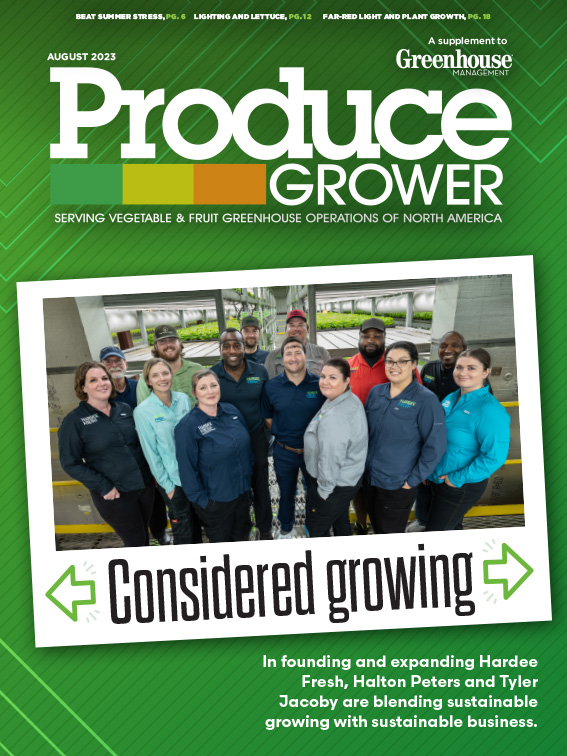

Sweltering heat. Full, intense sun. Thick humidity. And I am not even talking about inside the greenhouse yet! The summer is one of the toughest times in greenhouses, since our environment is at one of its least controllable time periods in the year. Sure, winter is no walk in the park. Given sufficient equipment and energy inputs (and avoiding any major failures!), we can usually achieve our target light intensities, air and nutrient solution temperatures, and relative humidity or vapor pressure deficits (VPD) throughout the winter. However, in the midst of the summer, the greenhouse can be more challenging to control, and light, air temperatures and water vapor often exceed desirable ranges for optimal crop growth and productivity and are challenging to reduce and maintain at acceptable levels. This article will highlight some of the most common disorders for hydroponic crops produced in the greenhouse during the summer, and how to deal with them.
Fruiting vine crops can be susceptible to a number of disorders during the summer, including blossom end rot, sunscald and reversion. Blossom end rot is a disorder where necrotic lesions form on the bottom of pepper and tomato fruits due to a calcium deficiency. While insufficient calcium in fertilizers can certainly be the culprit, the summer environment can also induce this disorder when sufficient or ample calcium is provided. Blossom end rot can occur when transpiration is lower due to low light or cool temperatures, and insufficient calcium is taken up. Interestingly, it can also be a problem when excessive transpiration occurs, and fruits are not able to compete with the strongly transpiring leaves for calcium.
Sunscald is a disorder that affects pepper fruits in the summer. As the name implies, excessive temperatures and light intensities cause necrotic lesions to form on the sides of fruit (as opposed to the bottom of the fruit where blossom end rot develops), generally on the south-facing side of fruits. Additionally, this tends to be more pronounced on fruits developing higher up on the vine as opposed to down below, due to the warmer temperatures. Aside from increasing the amount of shade used to reduce light intensity, pepper plants can be steered more towards vegetative growth to develop larger leaves and leaving a leaf or two on some axillary shoots. By increasing the canopy through more and larger leaves, this can help shade fruits and reduce the prevalence and severity of sunscald.
Reversion is something that is unique to tomato plants among the fruiting vines.
The high light intensity and warm temperatures can favor vegetative growth of tomato plants. Trying to reduce the light intensity and temperature may help, but as discussed, this can be challenging during the summer. Another approach is to reduce overall photosynthesis by thinning the canopy of tomato plants. The degree of leaf thinning is proportional to reduction desired, as more leaves removed reduces total canopy photosynthesis for tomato plants.
Leafy greens are not immune to the stresses of summer either. Similar to pepper and tomato crops, lettuce and some other leafy greens such as bok choi can suffer from an environmentally induced calcium deficiency. However, it manifests as tip burn, where the edges of leaves start to turn necrotic. Again, the cells on the margin of the leaf or in the center of the head cannot compete for calcium as well as other leaves when transpiration gets excessive. Trying to reduce transpiration by cooling and lowering light intensities, as well as vertical air flow fans for the centers of head-forming greens, can help move calcium into susceptible tissues.
Bolting, or premature flowering, can be another problem for leafy crops in the summer. The long day photoperiods and warm temperatures of the summer can induce flowering for greens such as lettuce and spinach, as well as some culinary herbs. Not only does the appearance and morphology of plants change when they bolt (like head lettuce elongating), flavor can be negatively affected as well. Since it is challenging to control heat in the summer, and shortening the day length is not feasible, the best option is to harvest sooner before bolting appears. Some growers have achieved this by aggregating smaller plants together to meet package weight goals, such as putting two smaller heads of butter lettuce together to equal the weight of a single large head. Always check with your customers prior to doing this to make sure the product is still acceptable.
Maintaining crop productivity and produce quality are year-round goals, and summer can be a challenging time inside any controlled environment, especially greenhouses. While we may not be able to beat the heat, hopefully you can cheat it a bit with the suggestions outlined in this article.

Explore the August 2023 Issue
Check out more from this issue and find your next story to read.
Latest from Produce Grower
- Chilli thrips (Scirtothrips dorsalis)
- GS1 US Celebrates 50-Year Barcode 'Scanniversary' and Heralds Next-Generation Barcode to Support Modern Commerce
- University of Florida offers Greenhouse Training Online program on irrigation water
- Flower trends in full bloom
- Nominate an outstanding leader
- New Florida Extension Agent Will Teach Stakeholders About Food Safety
- Paint it black
- Regular checkups





